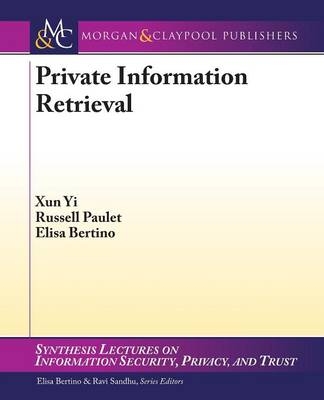
Private Information Retrieval
Seiten
2013
Morgan and Claypool Life Sciences (Verlag)
978-1-62705-153-8 (ISBN)
Morgan and Claypool Life Sciences (Verlag)
978-1-62705-153-8 (ISBN)
- Lieferbar
- Versandkostenfrei
- Auch auf Rechnung
- Artikel merken
Explores Private Information Retrieval (PIR), a technique allowing a user to retrieve an element from a server in possession of a database without revealing to the server which element is retrieved. PIR has been widely applied to protect the privacy of the user in querying a service provider on the Internet.
This book deals with Private Information Retrieval (PIR), a technique allowing a user to retrieve an element from a server in possession of a database without revealing to the server which element is retrieved. PIR has been widely applied to protect the privacy of the user in querying a service provider on the Internet. For example, by PIR, one can query a location-based service provider about the nearest car park without revealing his location to the server.
The first PIR approach was introduced by Chor, Goldreich, Kushilevitz and Sudan in 1995 in a multi-server setting, where the user retrieves information from multiple database servers, each of which has a copy of the same database. To ensure user privacy in the multi-server setting, the servers must be trusted not to collude. In 1997, Kushilevitz and Ostrovsky constructed the first single-database PIR. Since then, many efficient PIR solutions have been discovered.
Beginning with a thorough survey of single-database PIR techniques, this text focuses on the latest technologies and applications in the field of PIR. The main categories are illustrated with recently proposed PIR-based solutions by the authors.
Because of the latest treatment of the topic, this text will be highly beneficial to researchers and industry professionals in information security and privacy.
This book deals with Private Information Retrieval (PIR), a technique allowing a user to retrieve an element from a server in possession of a database without revealing to the server which element is retrieved. PIR has been widely applied to protect the privacy of the user in querying a service provider on the Internet. For example, by PIR, one can query a location-based service provider about the nearest car park without revealing his location to the server.
The first PIR approach was introduced by Chor, Goldreich, Kushilevitz and Sudan in 1995 in a multi-server setting, where the user retrieves information from multiple database servers, each of which has a copy of the same database. To ensure user privacy in the multi-server setting, the servers must be trusted not to collude. In 1997, Kushilevitz and Ostrovsky constructed the first single-database PIR. Since then, many efficient PIR solutions have been discovered.
Beginning with a thorough survey of single-database PIR techniques, this text focuses on the latest technologies and applications in the field of PIR. The main categories are illustrated with recently proposed PIR-based solutions by the authors.
Because of the latest treatment of the topic, this text will be highly beneficial to researchers and industry professionals in information security and privacy.
Preface
Acknowledgments
Classic Private Information Retrieval
FHE-Based Private Information Retrieval
Private Data Warehouse Queries
Privacy-Preserving Location-Based Queries
Discussion and Future Work
Bibliography
Authors' Biographies
| Erscheint lt. Verlag | 1.8.2014 |
|---|---|
| Reihe/Serie | Synthesis Lectures on Information Security, Privacy, and Trust |
| Verlagsort | San Rafael, CA |
| Sprache | englisch |
| Maße | 191 x 235 mm |
| Gewicht | 232 g |
| Themenwelt | Informatik ► Netzwerke ► Sicherheit / Firewall |
| Informatik ► Theorie / Studium ► Kryptologie | |
| ISBN-10 | 1-62705-153-8 / 1627051538 |
| ISBN-13 | 978-1-62705-153-8 / 9781627051538 |
| Zustand | Neuware |
| Haben Sie eine Frage zum Produkt? |
Mehr entdecken
aus dem Bereich
aus dem Bereich
Das Lehrbuch für Konzepte, Prinzipien, Mechanismen, Architekturen und …
Buch | Softcover (2022)
Springer Vieweg (Verlag)
CHF 48,95
Management der Informationssicherheit und Vorbereitung auf die …
Buch (2024)
Carl Hanser (Verlag)
CHF 97,95


